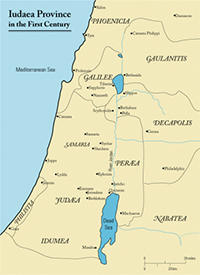The First Jewish Revolt against Rome
The Jewish Revolt of 66 was a large-scale uprising of Jewish people in Judea against Roman authority. It lasted for several years, was unsuccessful, and resulted in hundreds of thousands of deaths. 
Rome had annexed Judea in 63 B.C., after Pompey defeated King Mithridates VI of Pontus, sacking Jerusalem in the process. A series of procurators followed, the most famous of which were Herod, styled "King of the Jews," and Pontius Pilate, mentioned in the biblical story of the crucifixion of Jesus. Most of these procurators were more concerned with squeezing taxes out of the people who lived in Judea than with dealing with their concerns. Some procurators proved better administrators than others. One procurator whom Jewish people living in Judea found particularly abhorrent was Gessius Florus, who took over the reigns in 64. One of the acts that Jews found most egregious was the Roman takeover of the appointment process for the High Priest. This decision reflected a general Roman disregard for Jewish religious sensibilities, illustrated most fully by the emperor Caligula, who ordered that all temples in the Roman Empire, no matter which gods were worshiped therein, should have a statue of him inside. He had declared himself a god and expected to be worshiped as such; when the priests at the Jerusalem Temple refused to do so, Caligula threatened to destroy the Temple. Before he could do so, he was killed. Actions like these encouraged people like the Zealots, a group of Jewish people who harbored intense anti-Roman feelings and, in their highest hopes, would help rid their homeland of Roman troops and influence. One final outage from the procurator Florus sent people over the edge. In 66, Florus stole a large amount of silver from the Jerusalem Temple. A large group of enraged Jews rioted, killing not only the small Roman garrison stationed in Jerusalem but also a larger force dispatched there by the Syrian ruler Cestius Gallus. Rome responded to force with more force, sending 60,000 heavily armed soldiers to the area, led by the experienced soldier and future emperor Vespasian. Violent clash followed violent clash. The area known as the Galilee fell to Roman troops in 67; it was there that the historian Josephus surrendered and lived to tell the story of the revolt. Jewish fighters streamed from the battlefield to Jerusalem, there to make a last stand.  Following Caligula on the throne was Nero, who died in 68. He left no successor, and a struggle ensued that resulted in Vespasian's ending up on the throne, at the end of 69. He left his son Titus, also a future emperor, in charge of the Roman force in Judea. Titus it was who oversaw the final destruction of the Jewish revolt, including the near total destruction of Jerusalem. The Romans breached the walls of the city and then the Temple Mount itself, destroying the Temple itself and leaving just one wall standing. This is still known as the Wailing Wall. Even with Jerusalem destroyed, many small bands of rebellious Jews fought on, refusing to stop their war with Rome. The last refuge of these desperate soldiers was the mountain fortress of Masada. Roman soldiers captured that fortress in 73 not by force but by acclamation: Rather than submit to being captured, the remaining defendants had killed themselves. Historians estimate the final Jewish death toll during this revolt at more than 1 million and the number captured at 97,000. Rome was more firmly in control of Judea than ever.
|
|
Social Studies for Kids
copyright 2002–2025
David White




